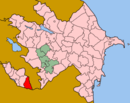Yuxarı Əylis
| Yuxarı Əylis | |
|---|---|
| Municipality | |
 Yuxarı Əylis | |
| Coordinates: 38°57′10″N 45°58′53″E / 38.95278°N 45.98139°ECoordinates: 38°57′10″N 45°58′53″E / 38.95278°N 45.98139°E | |
| Country |
|
| Autonomous republic | Nakhchivan |
| Rayon | Ordubad |
| Population [citation needed] | |
| • Total | 1,906 |
| Time zone | AZT (UTC+4) |
| • Summer (DST) | AZT (UTC+5) |
Yuxarı-Aylis (Azerbaijani: Yuxarı Əylis; Armenian: Վերին Ագուլիս, Verin Agulis)[1] is a village and municipality in the Ordubad Rayon of Nakhchivan, Azerbaijan. It has a population of 1,906.
History
Yuxarı-Aylis was first mentioned in historical sources in the 11th century under the Armenian name "Argulik.'" Its Armenian population specialized in the production of handicraft and sericulture and in the sixteenth century, numerous sources spoke of it as a thriving town that maintained strong commercial links with India, Russia, Safavid Persia and Western Europe.[2]
In the 18th century, Agulis had its own schools, a library, a silkworm factory, a large market. The town itself was enclosed by walls and surrounded by orchards and vineyards. Its Armenian population at the time was recorded at 8,000 households.[2] In 1752, the town was captured and subjected to a heavy sack by the armies of Azat Khan, the ruler of Āzarbāijān.[2] The town was incorporated into the Russian Empire in 1828, following the Russo-Persian War. By 1897, when a census was carried out by the Russian government, Agulis' population had dropped to 1,670.
In the 19th century, Verin ("Upper") Agulis, together with the adjoining Nerkin ("Lower") Agulis, was a major Armenian settlement in the Nakhichevan uyezd, with twelve churches and monasteries. The most important church was the St. Thomas the Apostle Monastery, whose date has not been recorded, although inscriptions mention that it was restored in 1694.[2] The monastery was also once a major center for learning, producing a number of prominent intellectuals including Zak'aria Aguletsi, A. Araskhanyan, A. K'alant'ar and L. Manvelyan.[2]
Destruction
In the spring of 1919, the Democratic Republic of Armenia extended administrative control over the region of Sharur-Nakhichevan, with Agulis being made the center for the subregion of Goghtan. But in the summer of the year, a Muslim insurgency broke out against Armenian rule, and in August the region came under the control of the newly appointed commissar of Ordubad, Abbas Guli Bey Tairov.[3] Agulis pledged its loyalty to Tairov, although in the following months, its inhabitants faced a growing food crisis and were not allowed to leave the town. The plight of its inhabitants worsened when, in November of that year, the Azerbaijan Democratic Republic unsuccessfully attempted to wrest the region of Zangezur from Armenian control.[4]
On December 17–18, a frenzied mob made up of Muslims, including refugees fleeing from the fighting in Zangezur, made its way to Lower Agulis and began to attack its Armenian inhabitants, forcing them to retreat to the upper town.[5] On December 24, the mob, joined by the local Azerbaijani gendarmerie, entered Upper Agulis and started to pillage the town. They then proceeded to massacre its Armenian population, leaving Upper Agulis in smoldering ruins the next day. According to figures provided by the Armenian government, up to 400 Armenians were killed in Lower Agulis and up to 1,000 in Upper Agulis.[6]
The town was partially rebuilt during the Soviet period.
Cultural references
The 1919 destruction of Agulis is referred to in the controversial 2012 novella Stone Dreams by Azerbaijani writer Akram Aylisli.[7]
Notable natives
- Ziya Kyazim — Azerbaijani Soviet actor, People's Artist of Azerbaijan SSR (1943)[8]
Notes
- ↑ Other transcriptions also include Agoulis, Akulis, Akulisy, Yukhari-Aylis, Yukhary Aylis and Yukhary-Akulis.
- ↑ 2.0 2.1 2.2 2.3 2.4 (Armenian) Barkhudaryan, Sedrak. «Ագուլիս» (Agulis). Armenian Soviet Encyclopedia. Yerevan: Armenian Academy of Sciences, 1974, vol. 1, p. 61.
- ↑ Hovannisian, Richard G. (1982). The Republic of Armenia, Vol. II: From Versailles to London, 1919-1920. Berkeley: University of California Press. p. 234. ISBN 0-520-04186-0.
- ↑ Hovannisian. Republic of Armenia, pp. 207-234.
- ↑ Hovannisian. Republic of Armenia, p. 235.
- ↑ Hovannisian. Republic of Armenia, pp. 236-238.
- ↑ "Matter of Copyright: Armenian publishers of novel by Azeri writer ready to pay compensation upon request." ArmeniaNow. April 18, 2013. Retrieved April 18, 2013.
- ↑ (Russian) "Кязим Зия". Great Soviet Encyclopedia.
Further reading
- (Armenian) Alishan, Ghevond. Սիսական (Sisakan). Venice: Mkhitarian Press, 1893.
- Ep'rikean, S. Պատկերազարդ բնաշխարիկ բառարան (Illustrated geographic dictionary), vol. 1. Venice: Saint Lazarus, 1902, pp. 4–15.
- Zak'aria of Agulis. The Journal of Zak'aria of Agulis. Armenian Studies Series, No. 4. Trans. George Bournoutian. Costa Mesa, CA: Mazda Publishers, 2002 ISBN 1-56859-107-1.
